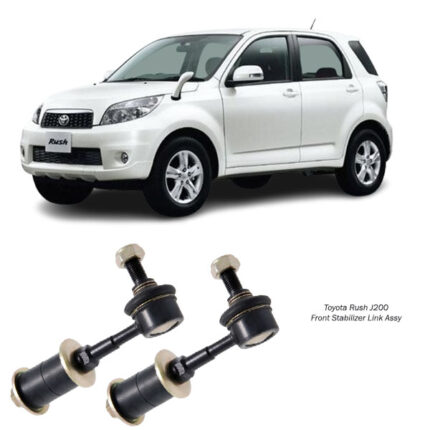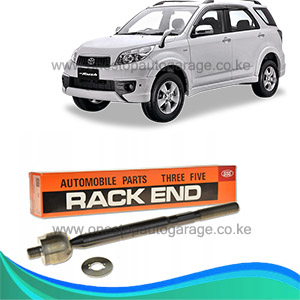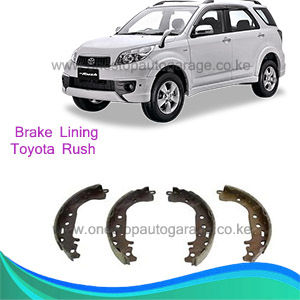-13%
Find the best prices for brake lining Toyota Rush in Nairobi Kenya
Within the intricate framework of a vehicle’s braking system, brake linings stand as crucial components tasked with converting kinetic energy into heat to bring the vehicle to a controlled stop. These linings, commonly found in drum brakes and certain types of disc brakes, play a pivotal role in ensuring safe and effective braking. This comprehensive guide will delve into the importance of brake linings and highlight the signs that indicate they may be worn out, requiring attention for sustained vehicle safety and optimal braking performance.
Importance of Brake Linings:
- Friction Generation: The primary function of brake linings is to generate friction when pressed against the brake drums or discs. This friction is essential for converting the kinetic energy of the moving vehicle into heat. The resulting heat dissipates into the surrounding air, allowing the vehicle to come to a controlled stop. The material composition of brake linings is designed to withstand high temperatures generated during the braking process.
- Effective Braking Force: Brake linings contribute significantly to the effective generation of braking force. The friction created between the brake linings and the brake drums or discs creates the resistance needed to slow down and stop the vehicle. Well-maintained brake linings ensure that the braking force is consistent, allowing for precise control and responsiveness when the brake pedal is applied.
- Temperature Management: Brake linings play a crucial role in managing the temperature generated during braking. The material composition of brake linings is engineered to provide effective friction while also dispersing heat efficiently. Proper temperature management is essential for preventing brake fade, where braking performance diminishes due to excessive heat, ensuring the brakes remain reliable under various driving conditions.
- Extended Brake System Lifespan: Regular and effective maintenance of brake linings contributes to the extended lifespan of the entire brake system. By ensuring that the linings are in good condition, drivers can prevent accelerated wear on other components such as brake drums, discs, and calipers. This proactive approach promotes overall brake system longevity, reducing the frequency of major brake system repairs.
Signs of Worn-Out Brake Linings:
- Squeaking or Squealing Noises: One of the earliest indicators of worn-out brake linings is the presence of squeaking or squealing noises during braking. These sounds are often caused by a wear indicator embedded in the brake lining material. When the linings become thin, the wear indicator contacts the brake drum or disc, producing audible warning signals. Addressing squeaking noises promptly can prevent further damage and ensure safe braking.
- Grinding Sounds: If brake linings wear down to a critical level, the metal backing of the brake pad may come into direct contact with the brake drum or disc. This contact produces a grinding sound, indicating severe wear and potential damage to both the brake linings and the braking components. Immediate inspection and replacement are crucial to avoid further complications and maintain safe braking.
- Reduced Braking Performance: Worn-out brake linings can lead to a noticeable reduction in braking performance. Drivers may experience increased stopping distances or a lack of responsiveness when applying the brakes. If the vehicle exhibits diminished braking effectiveness, it is a clear sign that the brake linings are in need of inspection and replacement to ensure optimal safety.
- Vibration or Pulsation: Uneven wear on brake linings can result in vibrations or pulsations felt through the brake pedal during braking. This uneven wear may cause an imbalance in the braking system, leading to a shaky or pulsating sensation. Addressing vibrations promptly is essential to prevent further damage to the brake linings and ensure a smoother and more controlled braking experience.
- Visible Wear Indicator: Some brake linings come equipped with a visual wear indicator. This is often a small groove or mark on the surface of the brake lining that becomes more prominent as the lining wears down. Inspecting the brake linings for the presence of these indicators can provide a visual cue about the remaining thickness of the linings and the need for replacement.
- Unusual Smells: Worn-out brake linings can produce an unusual odor, often described as a burning or metallic smell. This odor is a result of the excessive heat generated due to friction between the thinning brake linings and the brake drums or discs. Detecting such smells during or after braking indicates a critical level of wear and necessitates immediate attention.
- Dashboard Warning Lights: Modern vehicles are equipped with dashboard warning lights that can alert drivers to various issues, including brake system problems. If the brake system warning light illuminates on the dashboard, it may indicate issues with the brake linings or other components. Prompt inspection and diagnostics are essential to identify the specific cause and address it promptly.
Conclusion:
Brake linings play a pivotal role in ensuring the safety and effectiveness of a vehicle’s braking system. Recognizing the signs of worn-out brake linings is crucial for maintaining optimal braking performance and overall vehicle safety. Regular inspections, attentive listening for unusual sounds, and addressing any identified issues promptly contribute to sustained brake system health and provide drivers with confidence in their vehicle’s stopping power. By staying vigilant and responsive to these signs, vehicle owners can uphold the integrity of their brake linings, promoting safety on the road for themselves and others.



